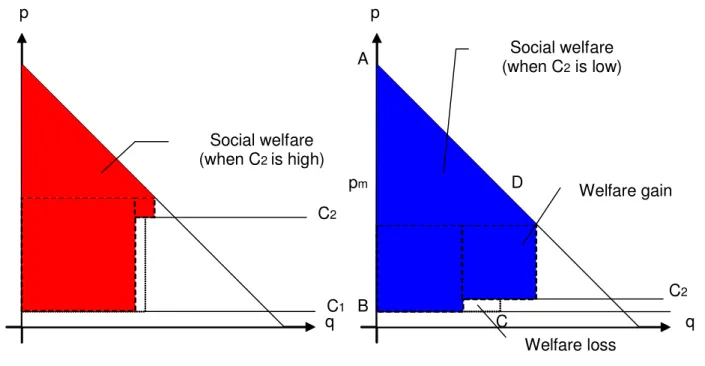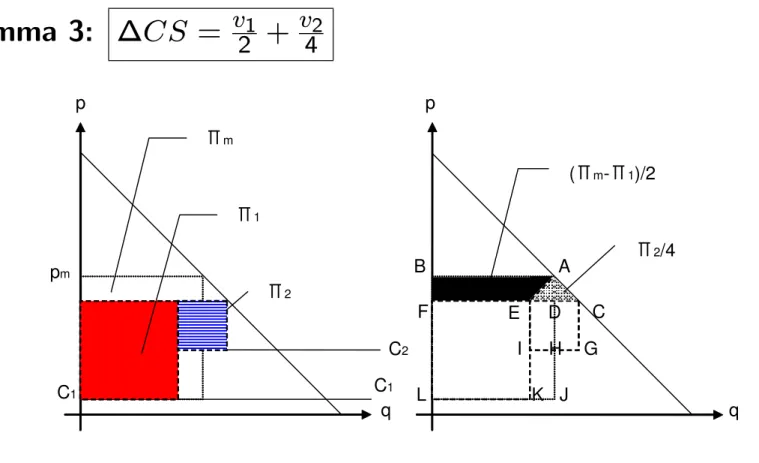The 40% Handicap Auction
Yosuke Yasuda
National Graduate Institute for Policy Studies (GRIPS)
June, 2011
Introduction
Allocating licenses is a signi…cant task for governments.
“Beauty Contest” ) “License Auctions”
Advantages: e¢cient, revenue, quick, transparent, ...
Examples: Airport slots, Bus routes, Radio spectra, ...
How many licenses to sell?
The government can choose the # of licenses to provide.
Auctions achieve e¢ciency given the # of licenses.
Impossible to decide the optimal # prior to the auction.
“market competition
(many licenses)
” vs. “production e¢ciency
(few licenses)
”
Free entry is not e¢cient
Excess Entry Theorem The equilibrium # of …rms in an oligopoly market under free entry is greater than the e¢cient # of …rms.
Symmetric …rms with …xed costs: Mankiw and Whinston (1986), Suzumura and Kiyono (1987)
Asymmetric …rms with no …xed cost: Lahiri and Ono (1988)
)Justi…cation of entry regulation.
)Optimal regulation can be implemented by license auctions.
European UMTS (3G) Auctions
Most of the countries set a number of licenses:
=
( # of incumbents in 2G services 1 + # of —
Essentially, either “accepting a new entrant” or “not.”
)Better auction design?
Monopoly or Duopoly?
Suppose a monopoly market.
A government provides a second license or not:
( No additional license Provide a license
) Monopoly ) Duopoly
Either a monopoly or a duopoly can be e¢cient.
The costs are private information of the …rms. )How to implement an optimal policy?
Mechanism Design Approach
VCG mechanism: simple but unworkable in our case (interdepen- dent value, consumer surplus)
No e¢cient mechanism under incomplete information.
Nash implementation (complete information): complicated, not observed in practice
)Impossible or too complicated in general settings.
The Benchmark Model
Homogenous good
Linear demand: p = a bq
2 …rms
( Incumbent Newcomer
: …rm 1 : …rm 2
Cournot competition
Constant marginal costs: ci; i = 1; 2
Welfare-Reducing Entry
Duopoly is more e¢cient than monopoly i¤ c2 < c
where c = 5a+17c22 1.
( c2 < c (low-cost) c2 > c (high-cost)
) Social Welfare " ) Social Welfare #
See the next …gures.
High-Cost or Low-Cost
p p
q q
C2
C1
pm
C2
Social welfare (when C2is high)
Social welfare (when C2 is low)
Welfare loss
Welfare gain A
B
C D
Figure 1: c2 is high (Left) c2 is low (Right)
The Beauty Contest
If the government knew the parameters a; c1; c2 ) optimal pol- icy.
Otherwise, what can we do?
)Auctions?
English (ascending bid) auction:
( Firm 1 wins: Firm 2 wins:
) Monopoly ) Duopoly
Benchmark assumptions
The government maximizes social welfare. )Generalized social welfare.
The …rms’ costs are common knowledge among …rms. )Asymmetric information.
The government can only control entry decision = No other reg- ulation (price or quantity regulations)
Valuations for the license
Each …rm’s valuation for the license: v1 = m 1 v2 = 2
Truthful bidding is optimal.
Entry occurs i¤
v1 < v2 , m 1 < 2
)Does this mechanism achieve e¢ciency?
Symmetric Firms (c1= c2)
A Duopoly is more e¢cient than a monopoly.
However, the incumbent wins (Gilbert and Newbery, 1982).
The monopoly pro…t is larger than the joint pro…t under duopoly.
m > 1 + 2 , m 1 > 2
Some kind of handicap favoring a newcomer is needed.
)Handicap auctions
Handicap (English) Auction with H
The auction stops when one …rm drops out.
The remaining bidder is the winner who obtains the license. )Similar to an English auction.
Only the payment of the newcomer is di¤erent.
( Incumbent: Newcomer:
Pay the winning price if it wins.
Pay only H of the winning price if it wins )The newcomer’s optimal strategy becomes “bidding vH2.”
Main Result
Theorem 1 The 40% handicap auction (H = 0:4) described as fol- lows implements entry i¤ duopoly is more e¢cient than monopoly.
( Incumbent: Newcomer:
Pay the winning price if it wins.
Pay only 40% of the winning price if it wins
) Why “40%”?
The sketch of the proof
SW = CS + P S = CS + 1 + 2 m
= CS + v2 v1 (SW)
CS can be expressed as follows (Lemma 3). CS = v21 + v42
Substituting it into (SW), we obtain the result. SW > 0 , v1
2 + v2
4 + v2 v1 > 0 , v1 < v2
0:4
Lemma 3: CS = v21 + v42
p p
q q
pm
C1 C1
C2
B A
C E D
F
G H I
J K L
Πm
Π2 Π1
(Πm-Π1)/2
Π2/4
Figure 2: Valuations (Left) CS in two parts (Right)
Remarks
Our auction does not depend on the parameters, a; b; c1; c2.
Demand functions need not be globally linear.
Robustness: welfare loss caused by introducing non-linearity is second order e¤ect. (Akerlof and Yellen, 1985)
E¢ciency is achieved by dominant strategies.
)Independent of the cost distributions.
Generalization
No incumbent …rm (= new market)
Asymmetric Information among …rms
Non-linear costs & demand
General social welfare functions
Multiple incumbents

